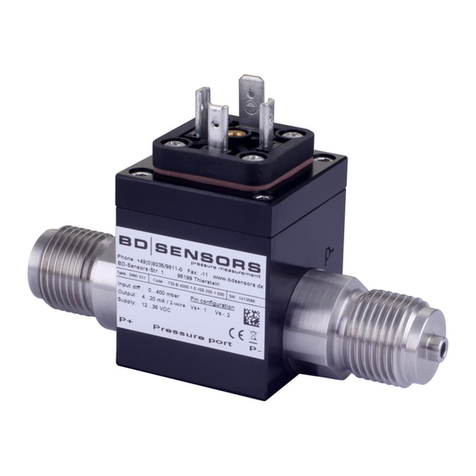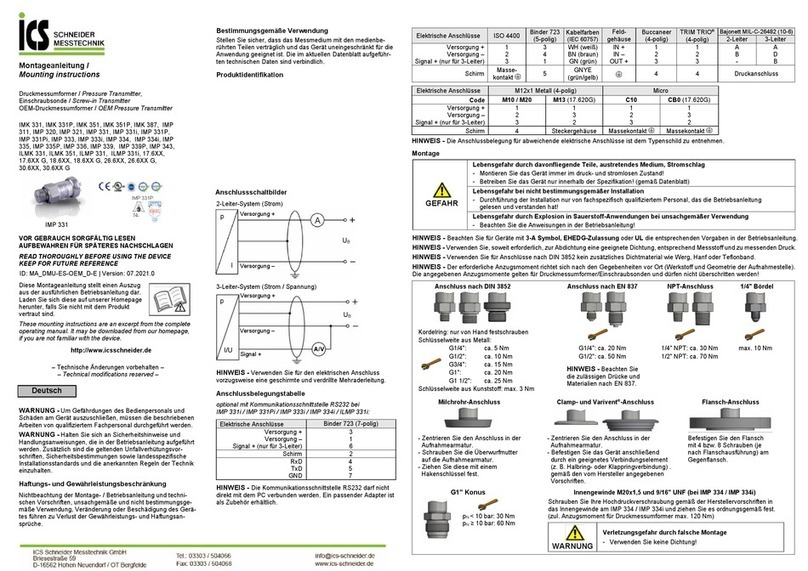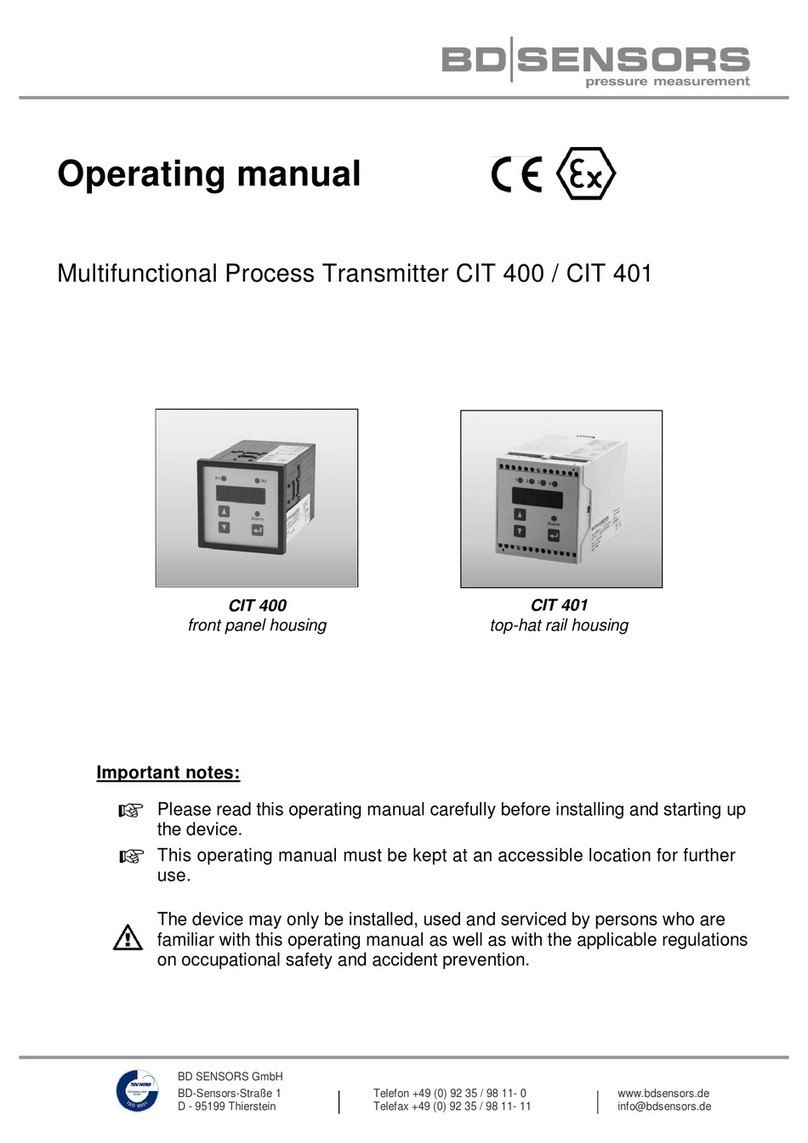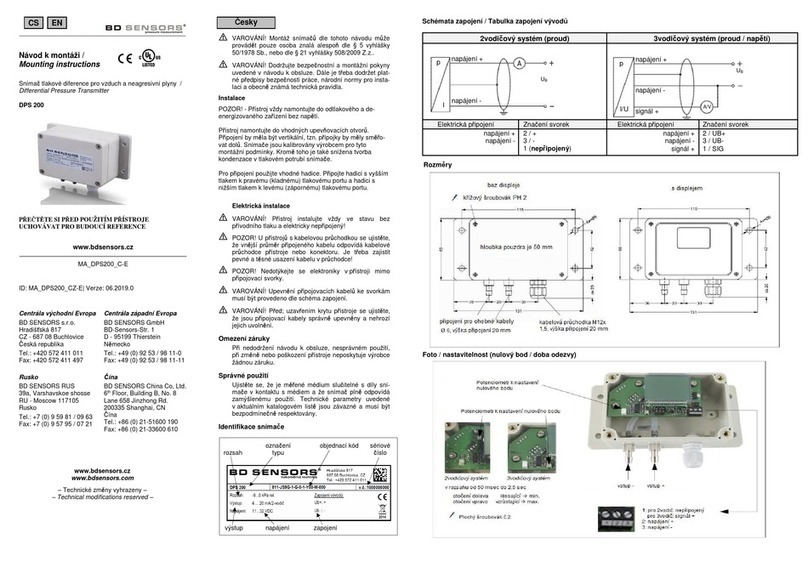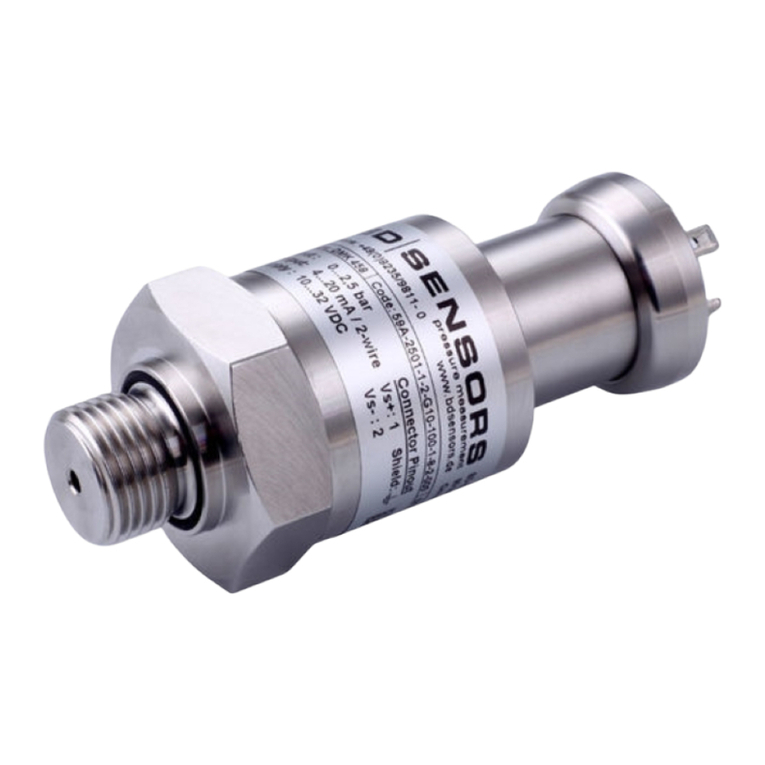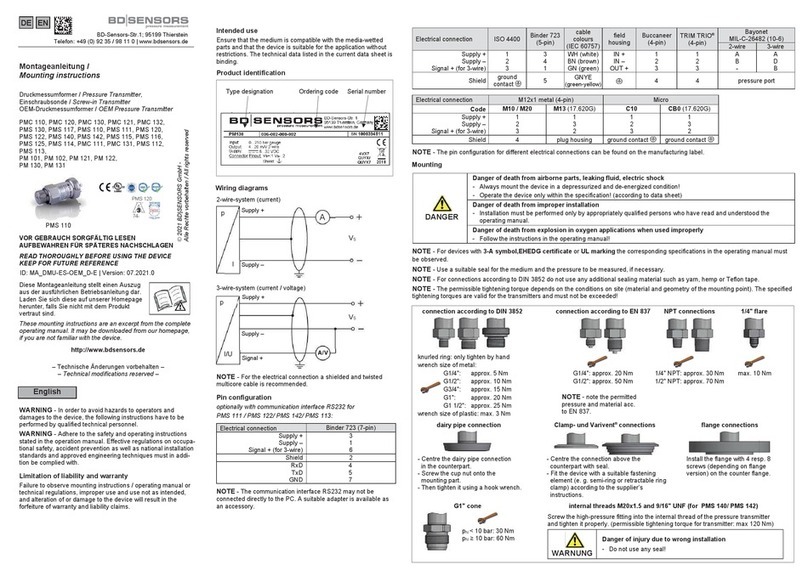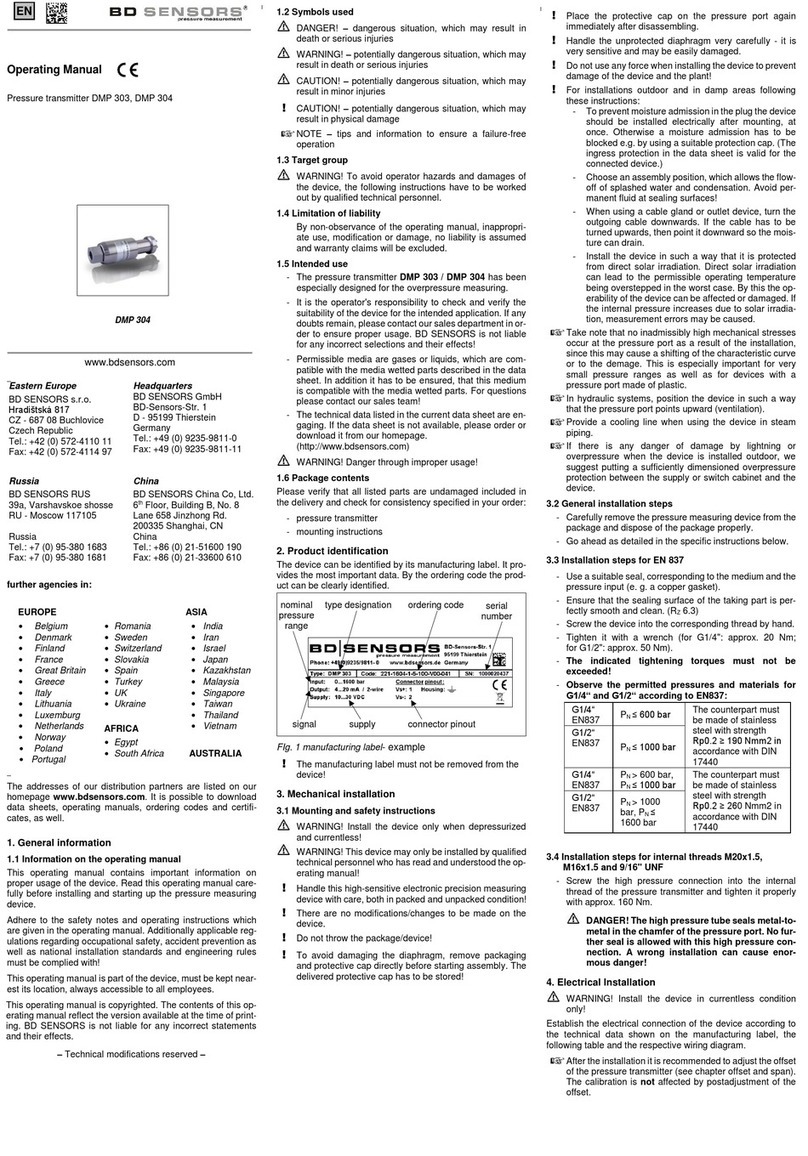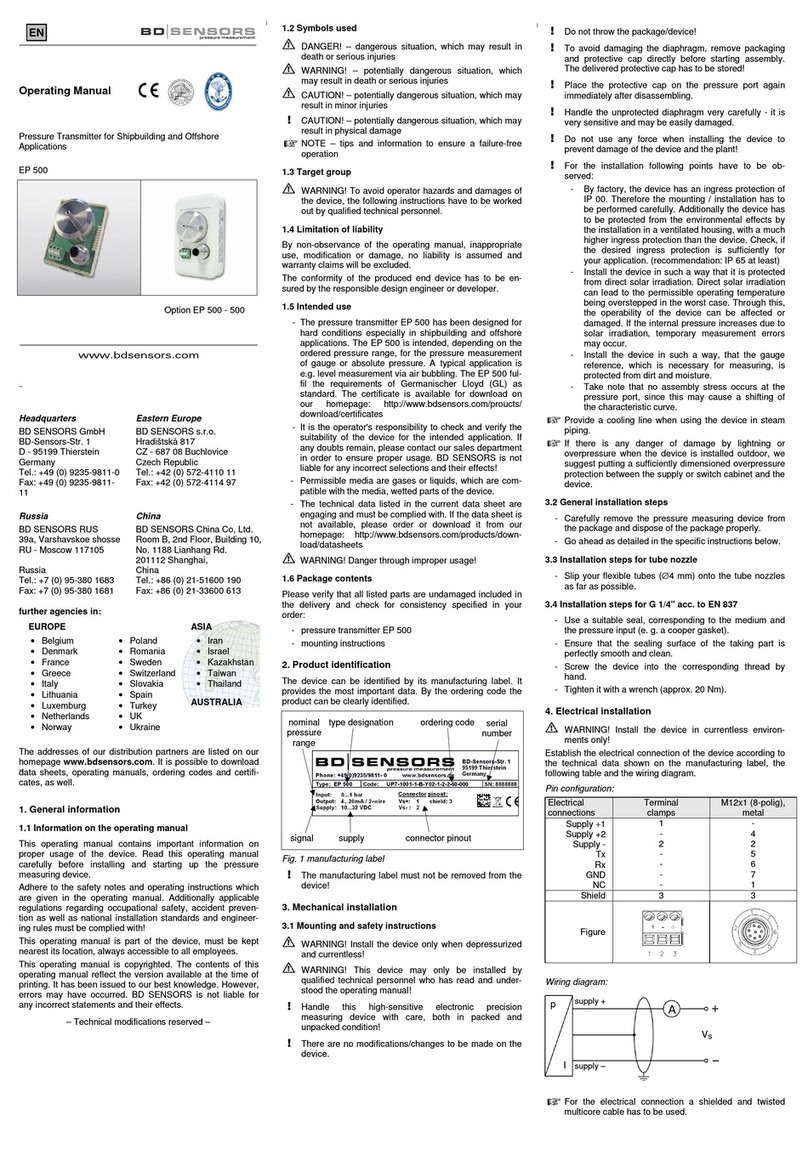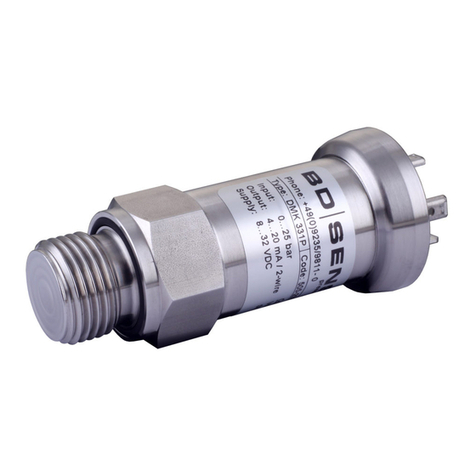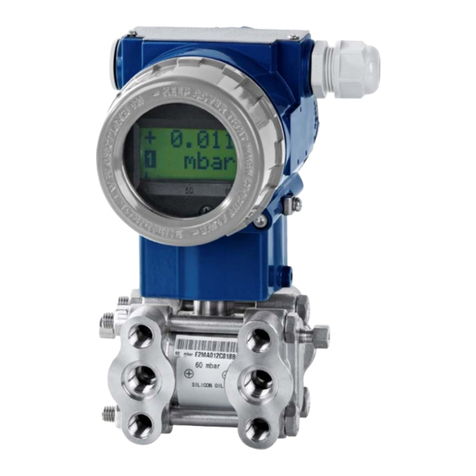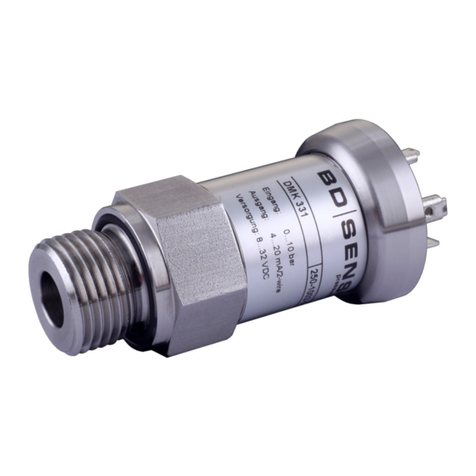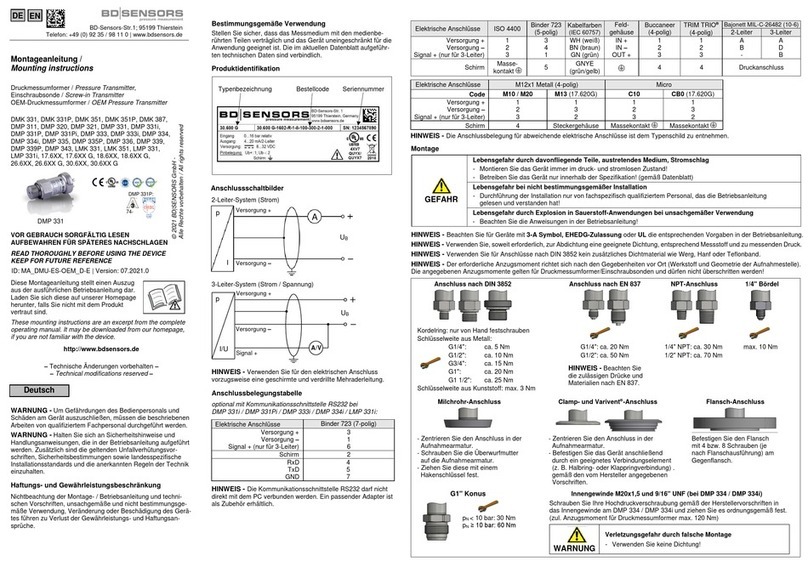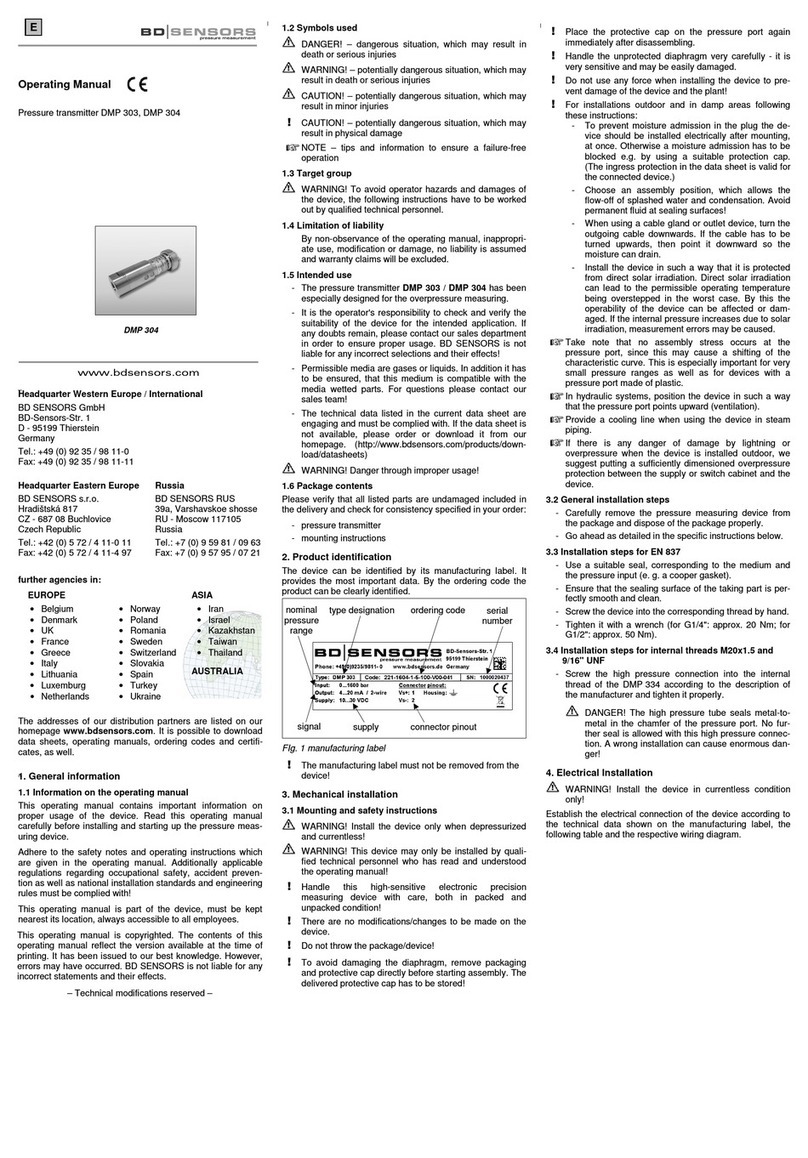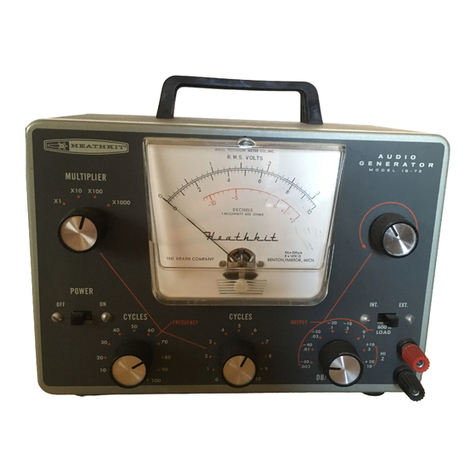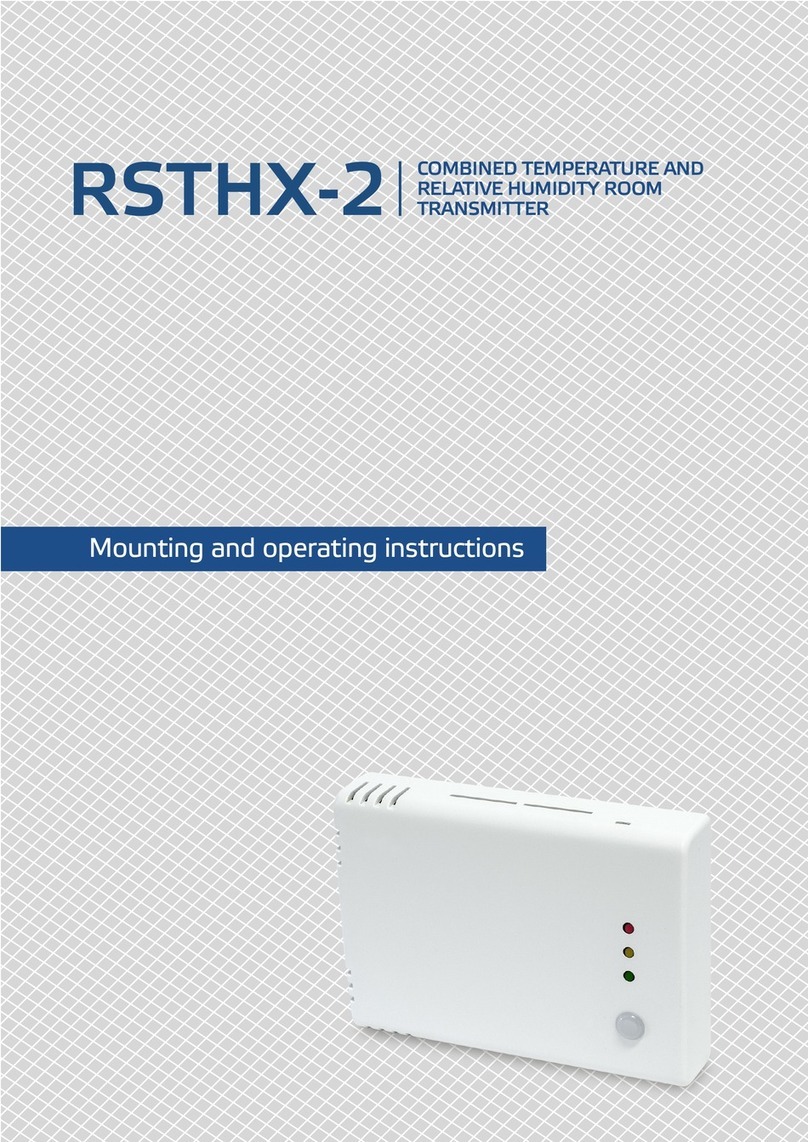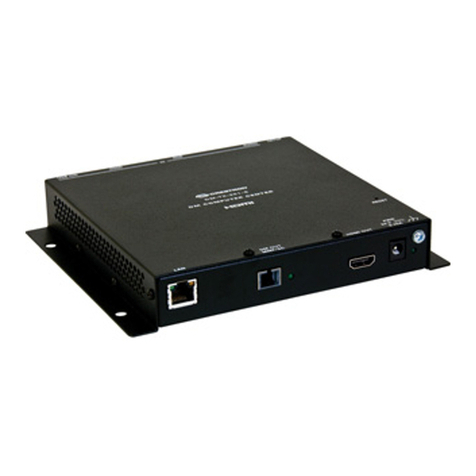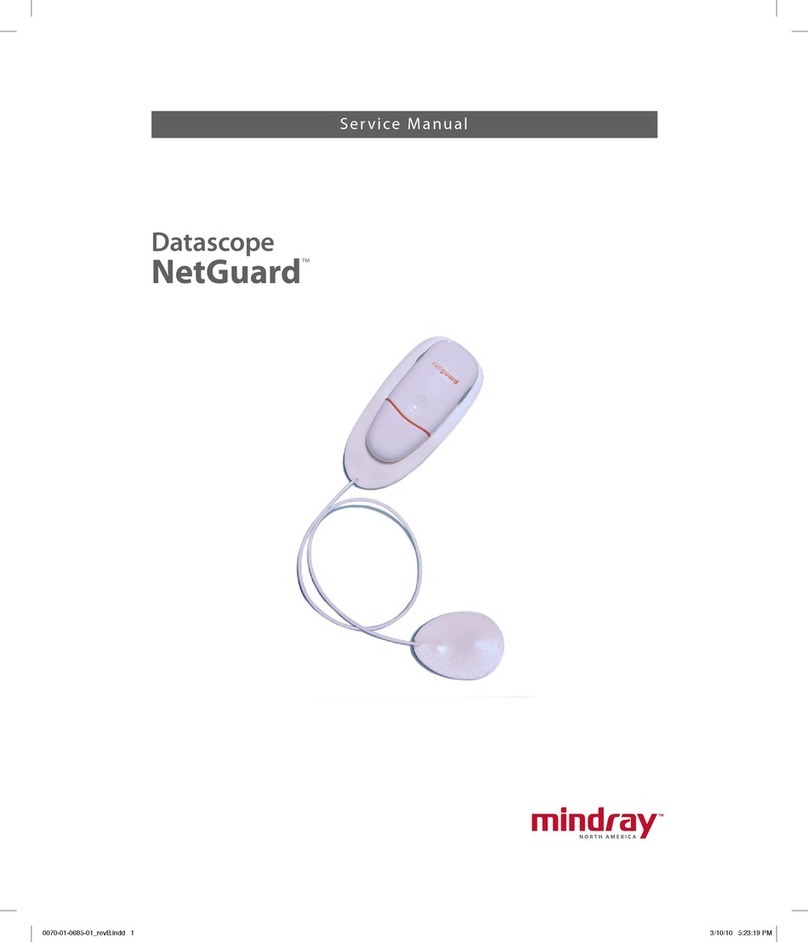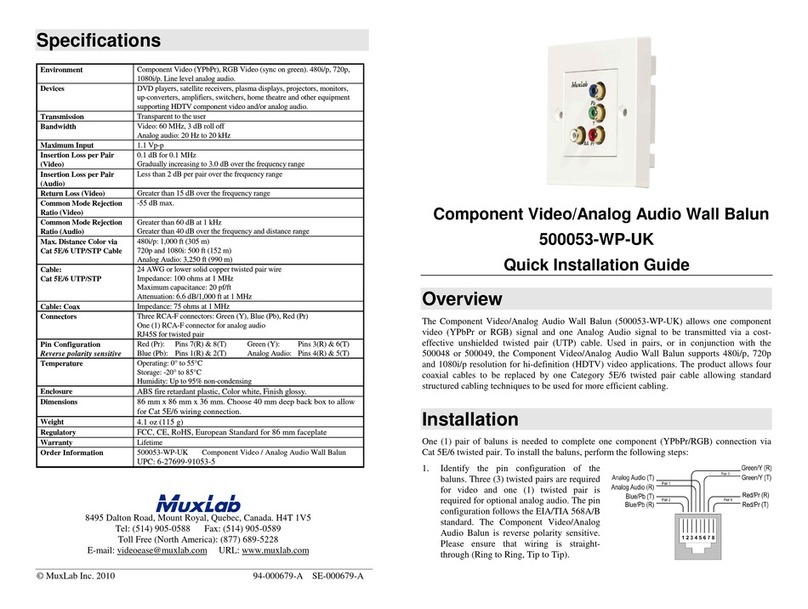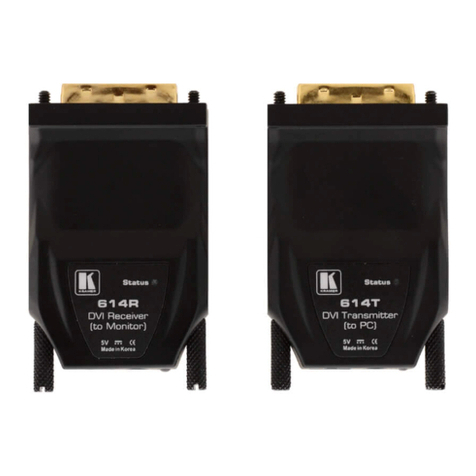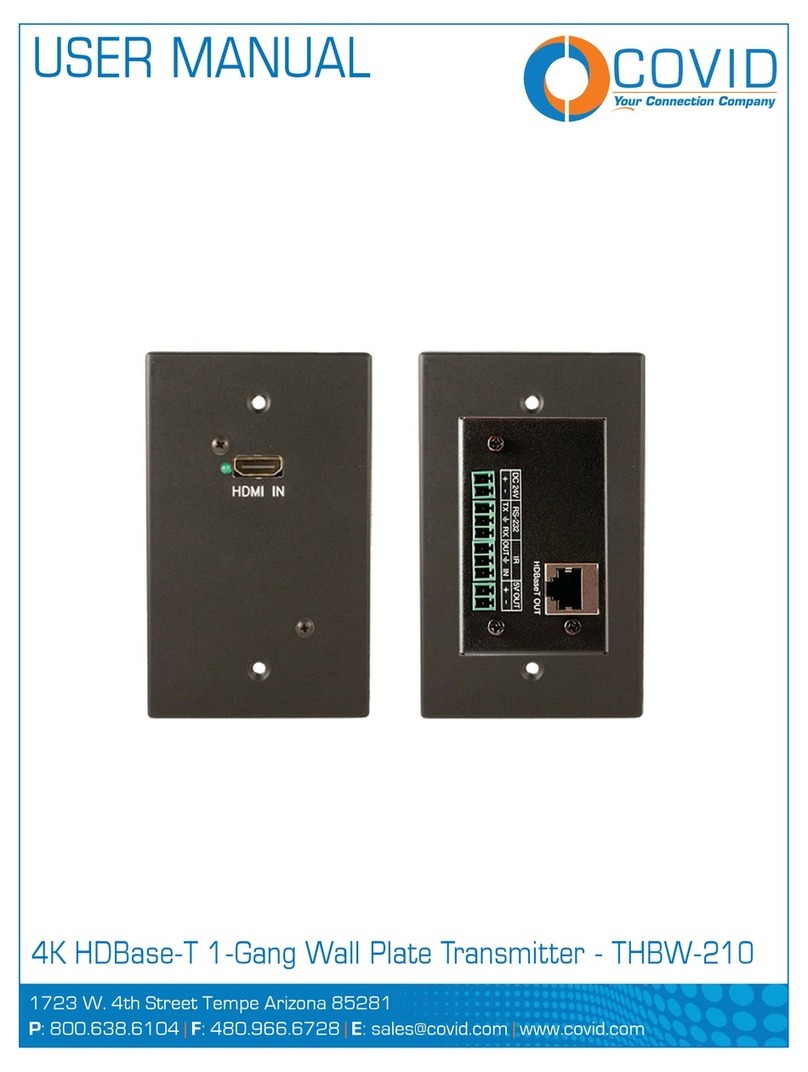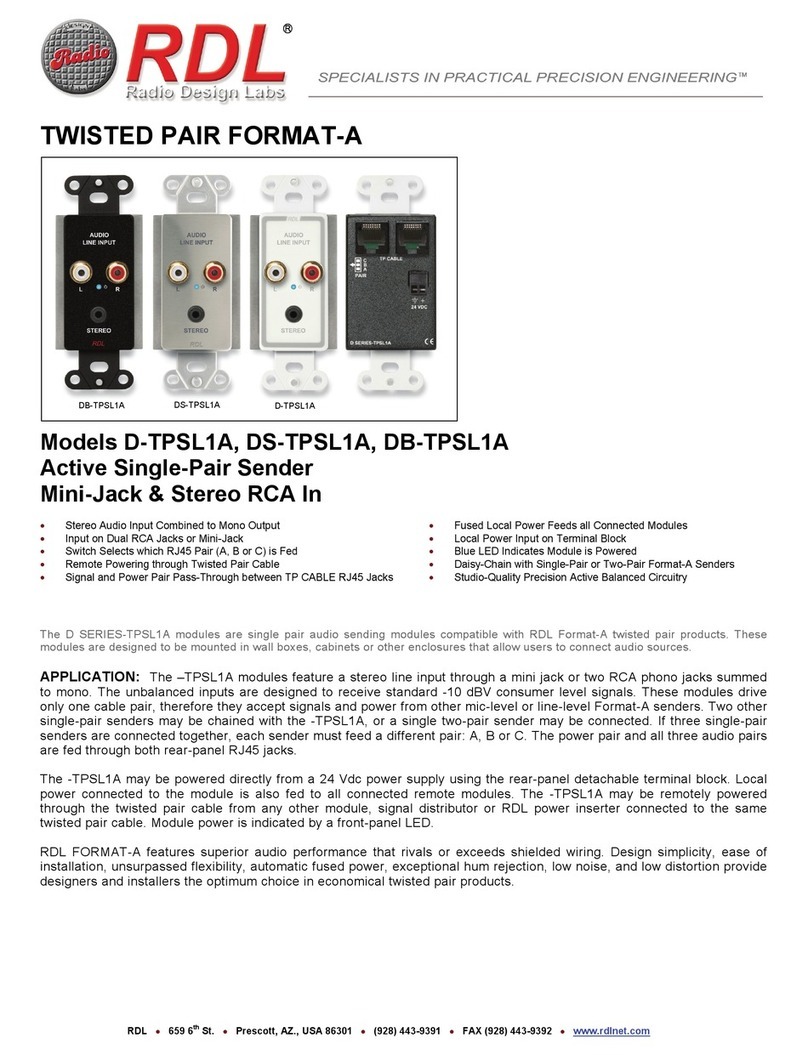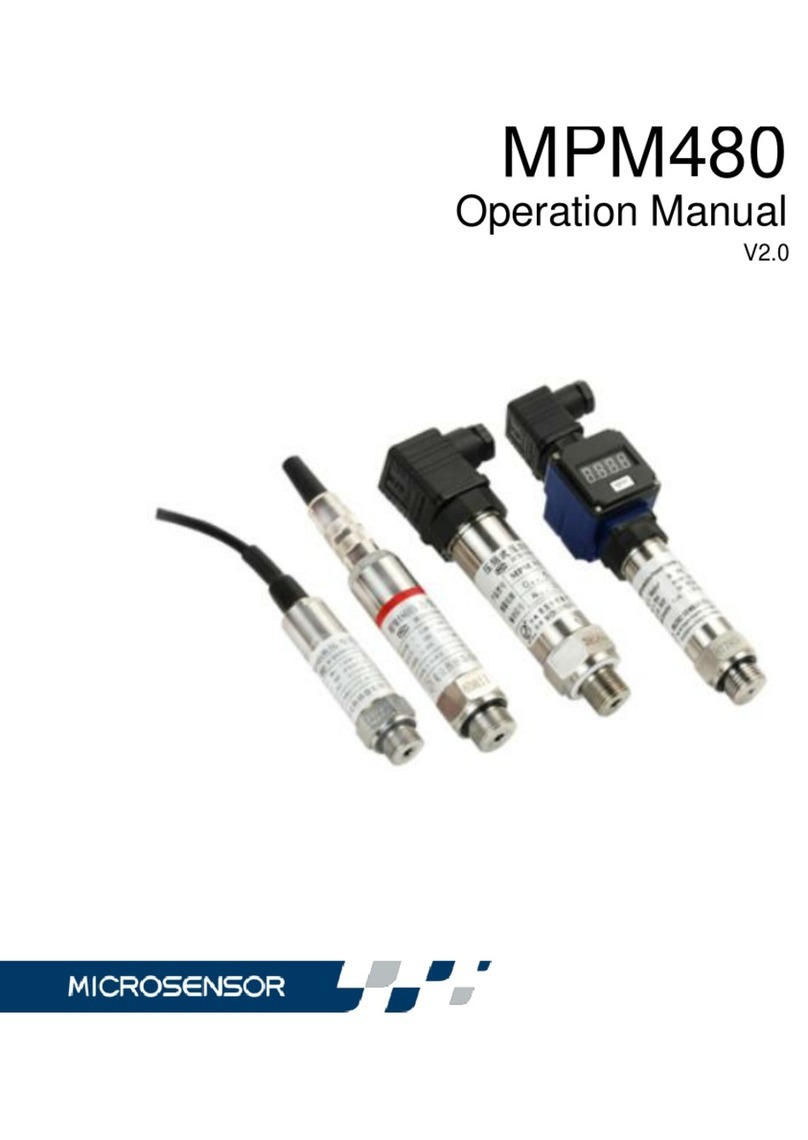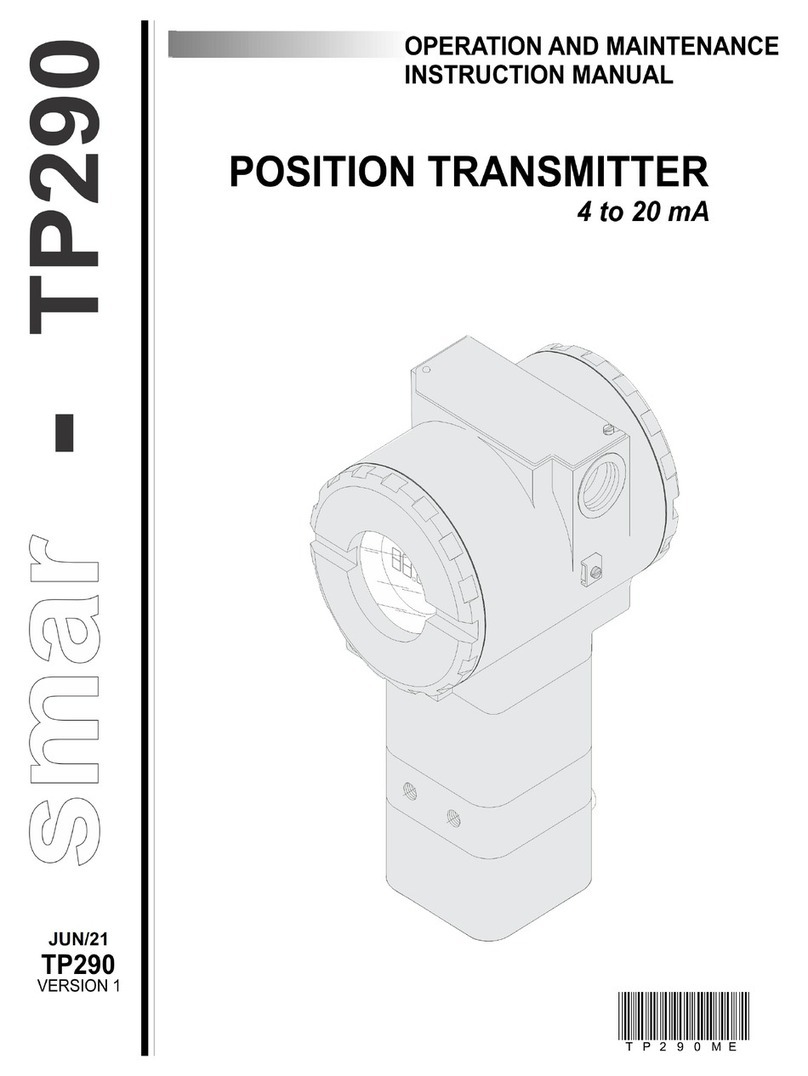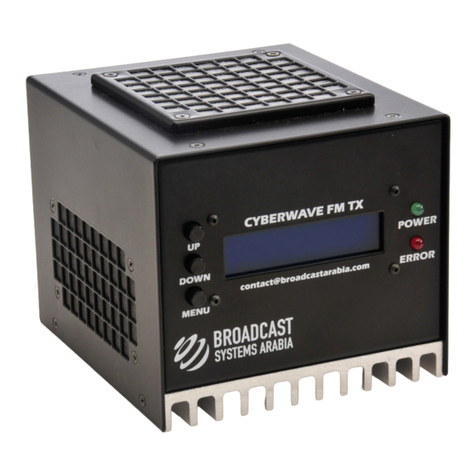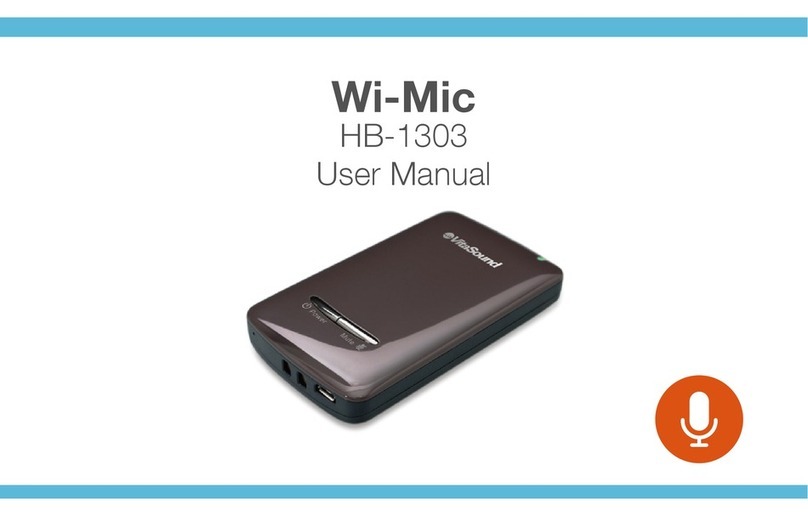
www.bdsensors.com
Operating Manual
Pressure transmitter DMP 303, DMP 304
Headquarters
BD SENSORS GmbH
BD-Sensors-Str. 1
D - 95199 Thierstein
Germany
Tel.: +49 (0) 9235-9811-0
Fax: +49 (0) 9235-9811-11
Eastern Europe
BD SENSORS s.r.o.
Hradištská 817
CZ - 687 08 Buchlovice
Czech Republic
Tel.: +42 (0) 572-4110 11
Fax: +42 (0) 572-4114 97
Russia
BD SENSORS RUS
39a, Varshavskoe shosse
RU - Moscow 117105
Russia
Tel.: +7 (0) 95-380 1683
Fax: +7 (0) 95-380 1681
China
BD SENSORS China Co, Ltd.
Room B, 2nd Floor, Building 10,
No. 1188 Lianhang Rd.
201112 Shanghai,
China
Tel.: +86 (0) 21-51600 190
Fax: +86 (0) 21-33600 613
further agencies in:
•Belgium
•Denmark
•Finland
•France
•Great Britain
•Greece
•Italy
•Lithuania
•Luxemburg
•Netherlands
•Norway
•Poland
•Portugal
•Romania
•Sweden
•Switzerland
•Slovakia
•Spain
•Turkey
•UK
•Ukraine
AFRICA
•Egypt
•South Africa
•India
•Iran
•Israel
•Japan
•Kazakhstan
•Malaysia
•Singapore
•Taiwan
•Thailand
•Vietnam
AUSTRALIA
The addresses of our distribution partners are listed on our
homepage www.bdsensors.com. It is possible to download
data sheets, operating manuals, ordering codes and certifi-
cates, as well.
1. General information
1.1 Information on the operating manual
This operating manual contains important information on
proper usage of the device. Read this operating manual
carefully before installing and starting up the pressure meas-
uring device.
Adhere to the safety notes and operating instructions which
are given in the operating manual. Additionally applicable
regulations regarding occupational safety, accident preven-
tion as well as national installation standards and engineering
rules must be complied with!
This operating manual is part of the device, must be kept
nearest its location, always accessible to all employees.
This operating manual is copyrighted. The contents of this
operating manual reflect the version available at the time of
printing. BD SENSORS is not liable for any incorrect state-
ments and their effects.
– Technical modifications reserved –
1.2 Symbols used
DANGER! – dangerous situation, which may result in
death or serious injuries
WARNING! – potentially dangerous situation, which may
result in death or serious injuries
CAUTION! – potentially dangerous situation, which may
result in minor injuries
!
CAUTION! – potentially dangerous situation, which may
result in physical damage
NOTE – tips and information to ensure a failure-free
operation
1.3 Target group
WARNING! To avoid operator hazards and damages of
the device, the following instructions have to be worked
out by qualified technical personnel.
1.4 Limitation of liability
By non-observance of the operating manual, inappropri-
ate use, modification or damage, no liability is assumed
and warranty claims will be excluded.
1.5 Intended use
- The pressure transmitter DMP 303 / DMP 304 has been
especially designed for the overpressure measuring.
- It is the operator's responsibility to check and verify the
suitability of the device for the intended application. If
any doubts remain, please contact our sales department
in order to ensure proper usage. BD SENSORS is not
liable for any incorrect selections and their effects!
- Permissible media are gases or liquids, which are com-
patible with the media wetted parts described in the data
sheet. In addition it has to be ensured, that this medium
is compatible with the media wetted parts. For questions
please contact our sales team!
- The technical data listed in the current data sheet are
engaging. If the data sheet is not available, please order
or download it from our homepage.
(http://www.bdsensors.com)
WARNING! Danger through improper usage!
1.6 Package contents
Please verify that all listed parts are undamaged included in
the delivery and check for consistency specified in your order:
- pressure transmitter
- mounting instructions
2. Product identification
The device can be identified by its manufacturing label. It
provides the most important data. By the ordering code the
product can be clearly identified.
FIg. 1 manufacturing label
!
The manufacturing label must not be removed from the
device!
3. Mechanical installation
3.1 Mounting and safety instructions
WARNING! Install the device only when depressurized
and currentless!
WARNING! This device may only be installed by quali-
fied technical personnel who has read and understood
the operating manual!
!
Handle this high-sensitive electronic precision
measuring device with care, both in packed and
unpacked condition!
!
There are no modifications/changes to be made on the
device.
!
Do not throw the package/device!
!
To avoid damaging the diaphragm, remove packaging
and protective cap directly before starting assembly. The
delivered protective cap has to be stored!
!
Place the protective cap on the pressure port again
immediately after disassembling.
!
Handle the unprotected diaphragm very carefully - it is
very sensitive and may be easily damaged.
!
Do not use any force when installing the device to pre-
vent damage of the device and the plant!
!
For installations outdoor and in damp areas following
these instructions:
- To prevent moisture admission in the plug the de-
vice should be installed electrically after mounting,
at once. Otherwise a moisture admission has to be
blocked e.g. by using a suitable protection cap.
(The ingress protection in the data sheet is valid for
the connected device.)
- Choose an assembly position, which allows the
flow-off of splashed water and condensation. Avoid
permanent fluid at sealing surfaces!
- When using a cable gland or outlet device, turn the
outgoing cable downwards. If the cable has to be
turned upwards, then point it downward so the
moisture can drain.
- Install the device in such a way that it is protected
from direct solar irradiation. Direct solar irradiation
can lead to the permissible operating temperature
being overstepped in the worst case. By this the
operability of the device can be affected or dam-
aged. If the internal pressure increases due to solar
irradiation, measurement errors may be caused.
Take note that no inadmissibly high mechanical stresses
occur at the pressure port as a result of the installation,
since this may cause a shifting of the characteristic
curve or to the demage. This is especially important for
very small pressure ranges as well as for devices with a
pressure port made of plastic.
In hydraulic systems, position the device in such a way
that the pressure port points upward (ventilation).
Provide a cooling line when using the device in steam
piping.
If there is any danger of damage by lightning or
overpressure when the device is installed outdoor, we
suggest putting a sufficiently dimensioned overpressure
protection between the supply or switch cabinet and the
device.
3.2 General installation steps
- Carefully remove the pressure measuring device from
the package and dispose of the package properly.
- Go ahead as detailed in the specific instructions below.
3.3 Installation steps for EN 837
- Use a suitable seal, corresponding to the medium and
the pressure input (e. g. a copper gasket).
- Ensure that the sealing surface of the taking part is per-
fectly smooth and clean. (R
Z
6.3)
- Screw the device into the corresponding thread by hand.
- Tighten it with a wrench (for G1/4": approx. 20 Nm;
for G1/2": approx. 50 Nm).
- The indicated tightening torques must not be
exceeded!
- Note: permitted pressure ranges according to
EN 837!
for G1/4“ and G1/2“ according to EN837:
G1/4“
EN837 P
N
≤600 bar Counterpart has to be of
steel according to
DIN17440 with strength
Rp0,2 ≥190 Nmm2
G1/2“
EN837 P
N
≤1000 bar
G1/4“
EN837
P
N
> 600 bar,
P
≤1000 bar
Counterpart has to be of
steel according to
DIN17440 with strength
Rp0,2 ≥260 Nmm2
G1/2“
EN837
P
N
> 1000 bar,
P
≤1600 bar
3.4 Installation steps for internal threads M20x1.5,
M16x1.5 and 9/16" UNF
- Screw the high pressure connection into the internal
thread of the pressure transmitter and tighten it properly
with approx. 160 Nm.
DANGER! The high pressure tube seals metal-
to-metal in the chamfer of the pressure port. No
further seal is allowed with this high pressure
connection. A wrong installation can cause
enormous danger!
4. Electrical Installation
WARNING! Install the device in currentless condition
only!
Establish the electrical connection of the device according to
the technical data shown on the manufacturing label, the
following table and the respective wiring diagram.
After the installation it is recommended to adjust the
offset of the pressure transmitter (see chapter offset and
span). The calibration is not affected by postadjustment
of the offset.
ordering code
connector pinout
type designation
supply
nominal
pressure
range
signal
serial
number


